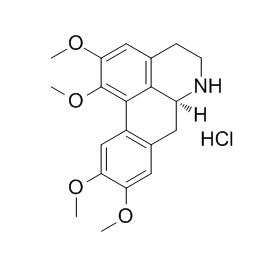Norglaucine hydrochloride
(+)-Norglaucine shows cytotoxic activity toward the tumor cell lines B16-F10 (mouse melanoma), HepG2 (human hepatocellular carcinoma), K562 (human chronic myelocytic leukemia) and HL-60 (human promyelocytic leukemia) and non-tumor peripheral blood mononuclear cells (PBMCs).
Inquire / Order:
manager@chemfaces.com
Technical Inquiries:
service@chemfaces.com
Tel:
+86-27-84237783
Fax:
+86-27-84254680
Address:
1 Building, No. 83, CheCheng Rd., Wuhan Economic and Technological Development Zone, Wuhan, Hubei 430056, PRC
Providing storage is as stated on the product vial and the vial is kept tightly sealed, the product can be stored for up to
24 months(2-8C).
Wherever possible, you should prepare and use solutions on the same day. However, if you need to make up stock solutions in advance, we recommend that you store the solution as aliquots in tightly sealed vials at -20C. Generally, these will be useable for up to two weeks. Before use, and prior to opening the vial we recommend that you allow your product to equilibrate to room temperature for at least 1 hour.
Need more advice on solubility, usage and handling? Please email to: service@chemfaces.com
The packaging of the product may have turned upside down during transportation, resulting in the natural compounds adhering to the neck or cap of the vial. take the vial out of its packaging and gently shake to let the compounds fall to the bottom of the vial. for liquid products, centrifuge at 200-500 RPM to gather the liquid at the bottom of the vial. try to avoid loss or contamination during handling.
Nutrients.2023, 15(13):2960.
ACS Omega.2023, 8(36):32424-32431.
Pharmaceuticals (Basel).2021, 14(8):742.
Trop J Pharm Res.2023, 22(3):283-288.
Anim Cells Syst (Seoul).2024, 28(1):381-391.
J. Pharm. Biomed. Anal.2024, 245:116193.
Comput Biol Chem.2019, 83:107096
LWT2021, 138:110397.
Molecules.2022, 27(7):2360.
Nat Commun.2021, 12(1):681.
Related and Featured Products
Molecules. 2016 Jul 8;21(7). pii: E890.
Cytotoxic Alkaloids from the Stem of Xylopia laevigata.[Pubmed:
27399666 ]
Xylopia laevigata (Annonaceae), known locally as "meiú" or "pindaíba", is widely used in folk medicine in Northeastern Brazil.
METHODS AND RESULTS:
In the present work, we performed phytochemical analyses of the stem of X. laevigata, which led to the isolation of 19 alkaloids: (-)-roemerine, (+)-anonaine, lanuginosine, (+)-glaucine, (+)-xylopine, oxoglaucine, (+)-norglaucine, asimilobine, (-)-xylopinine, (+)-norpurpureine, (+)-N-methyllaurotetanine, (+)-norpredicentrine, (+)-discretine, (+)-calycinine, (+)-laurotetanine, (+)-reticuline, (-)-corytenchine, (+)-discretamine and (+)-flavinantine. The in vitro cytotoxic activity toward the tumor cell lines B16-F10 (mouse melanoma), HepG2 (human hepatocellular carcinoma), K562 (human chronic myelocytic leukemia) and HL-60 (human promyelocytic leukemia) and non-tumor peripheral blood mononuclear cells (PBMCs) was tested using the Alamar Blue assay. Lanuginosine, (+)-xylopine and (+)-norglaucine had the highest cytotoxic activity. Additionally, the pro-apoptotic effects of lanuginosine and (+)-xylopine were investigated in HepG2 cells using light and fluorescence microscopies and flow cytometry-based assays. Cell morphology consistent with apoptosis and a marked phosphatidylserine externalization were observed in lanuginosine- and (+)-xylopine-treated cells, suggesting induction of apoptotic cell death. In addition, (+)-xylopine treatment caused G₂/M cell cycle arrest in HepG2 cells.
CONCLUSIONS:
These data suggest that X. laevigata is a potential source for cytotoxic alkaloids.



